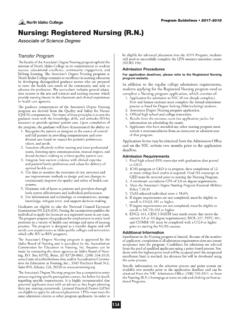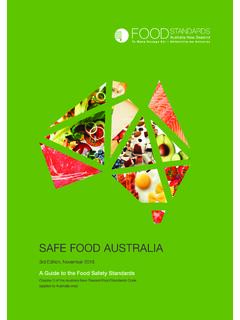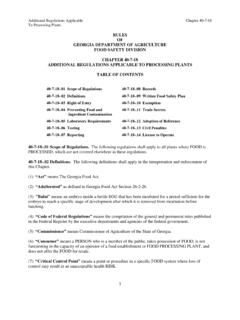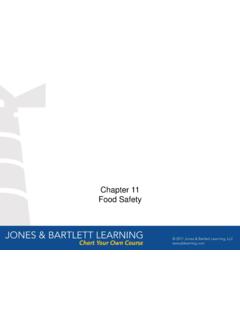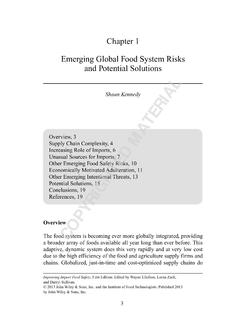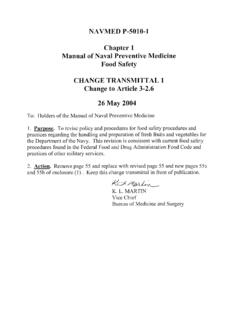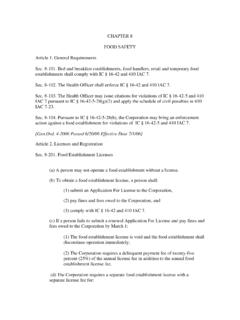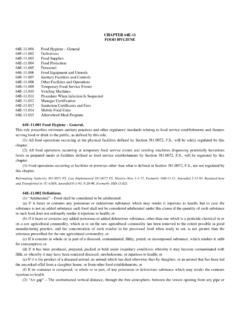Transcription of CHAPTER 1 THE FOOD-SERVICE INDUSTRY
1 CHAPTER 1 THE FOOD-SERVICE INDUSTRY CHAPTER Goals After studying this CHAPTER , the student should be able to: 1. Name and describe four major developments that have significantly changed the food service INDUSTRY in the 20th century. 2. Identify seven major stations in a classical kitchen. 3. Explain how the size and type of an operation influence the organization of the modern. 4. Identify and describe three skill levels of food production personnel. 5. Identify eight behavioral characteristics that food service workers should develop and maintain to achieve the highest standards of professionalism. CHAPTER Outline Points of emphasis I. A History of Modern food Service The development of modern kitchens and cooking techniques. The importance of Escoffier s contributions.
2 The influence of modern technology on food service. II. The Organization of Modern Kitchens The purpose of kitchen operations; types of food service operations; stations or positions in modern kitchens; skills required for various jobs. III. Standards of Professionalism Importance of professional attitudes; importance of experience. CHAPTER Overview and Suggestions This CHAPTER gives the students an overall view of the profession they are entering. Most instructors find that students like to read this kind of background information, to help them put the INDUSTRY in perspective. Instructors with limited class time may wish to assign this CHAPTER as outside reading. The discussion of professionalism has the most direct bearing on the students' ultimate success in their careers.
3 The topics of sous vide and molecular gastronomy are introduced in this CHAPTER , but more detailed discussion of these topics is included in CHAPTER 4. If time is available: visit a commercial kitchen, either as a class or as individual assignments. Students write a report on their observations, including the following information: Type of facility (restaurant, hospital kitchen, etc.) and the type of foods being prepared. Size of facility (number of employees, number of meals served). Titles of employees, tasks being performed by each, and the skills required. Follow with class discussion of observations and impressions. Key Points to Review How have the following developments changed the food service INDUSTRY : development of new equipment; availability of new food products; greater understanding of food safety and nutrition?
4 How have international cuisines influenced and changed cooking in North America? What are the major stations in a classical kitchen? What are their responsibilities? How do the size and type of a food service operation affect how the kitchen is organized? What are the three basic skill levels of modern kitchen personnel? What are eight personal characteristics that are important to the success of a food service professional? CHAPTER 2 SANITATION AND SAFETY CHAPTER Goals After studying this CHAPTER , the student should be able to: 1. Describe steps to prevent food poisoning and food -borne diseases in the following areas: personal hygiene; food handling and storage techniques; cleaning and sanitizing procedures; and pest control. 2. Demonstrate safe workplace habits that prevent injuries from the following: cuts, burns, operation of machinery and equipment, and lifting.
5 3. Identify safe workplace habits that minimize the likelihood of fires and falls. CHAPTER Outline Points of emphasis Sanitation I. food Hazards II. Personal Hygiene Hazards: Biological Chemical Physical Conditions for bacteria growth: food Moisture Temperatures between 41 and 135 F (5 and 57 C): food Danger Zone Air (for aerobic bacteria) or lack of air (for anaerobic bacteria) Time Protection: Keep bacteria from spreading Keep bacteria from growing. Kill bacteria Emphasize means of prevention of the diseases listed. Most food -borne diseases are caused by bacteria spread by food workers. III. food Storage Prevent contamination of foods. Prevent growth of bacteria in foods The food Danger Zone V. food Handling and Preparation VI.
6 Cleaning and Sanitizing Equipment VII. Rodent and Insect Control VIII. Setting Up a System for food Safety Safety I. The Safe Workplace II. Preventing Cuts III. Preventing Burns IV. Preventing and Dealing with Fires V. Preventing Injuries from Machines and Equipment VI. Preventing Falls VII. Preventing Strains and Injuries Prevent cross-contamination Keep foods out of the food Danger Zone Minimum Safe Internal Temperatures Emphasize proper procedures. "Build them out" is the best protection. Introduction to HACCP Safety as an attitude. Discuss safety as related to practical situations, not just as a list of rules to be memorized. CHAPTER Overview and Suggestions It is important to introduce students to principles of sanitation and safety before they actually begin to work in the laboratory.
7 You may wish to combine this CHAPTER with CHAPTER 3 (Tools and Equipment) as part of the students' orientation to the laboratory. Discuss and demonstrate equipment necessary for cleaning, sanitation, and food storage. Emphasize personal hygiene, clean, neat uniforms, etc. Demonstrate safe practices such as how to carry knives, lift and carry heavy objects, and move safely in a crowded, busy kitchen. Identify dangerous equipment and demonstrate safe use (see CHAPTER 3). Have students practice under careful supervision. Key Points to Review What six conditions are necessary for the growth of bacteria? What are potentially hazardous foods? What are the three ways to protect against bacteria? Besides bacteria, what other hazards can make food unsafe? What is cross-contamination?
8 What are the important rules of personal hygiene? List as many as you can. What is the food Danger Zone? What is the four-hour rule? What does minimum internal cooking temperature mean? How should cooked foods be cooled? What are the steps in the procedure for manual dishwashing? for mechanical dishwashing? What are the four ways to protect against rodents and insects? Which of these is the most effective? What does the term flow of food mean? What does the term critical control point mean? What are the seven steps of the HACCP system? What workplace habits can help you prevent injuries from cuts and burn and from kitchen equipment? How can you prevent fires in the kitchen? CHAPTER 3 TOOLS AND EQUIPMENT CHAPTER Goals After studying this CHAPTER , the student should be able to: Identify the do s and don ts associated with the safe and efficient use of standard cooking equipment, processing equipment, holding and storage equipment, measuring devices, and knives, hand tools, and small equipment.
9 CHAPTER Outline Outline and page numbers Points of emphasis I. Introduction to Quantity food Equipment II. Cooking Equipment III. Processing Equipment IV. Holding and Storage Equipment V. Pots, Pans, and Containers VI. Measuring Devices VII. Knives, Hand Tools, and Small Equipment Importance of understanding the proper, safe handling and maintenance of all equipment. Importance of practicing energy conservation. Identification and correct use of all equipment in your laboratory and in students tool kits. CHAPTER Overview and Suggestions This CHAPTER is organized as a sort of catalog of basic equipment and can be used as a unit of study, as part of the students orientation to the laboratory, and as a reference tool throughout the students lab work.
10 Guidelines for use of large equipment are included. This information should be related to the specific equipment and models in your laboratory. Demonstrate equipment in your lab, including use, safety features, location of printed instructions on the equipment s operation, breakdown, and cleaning. After demonstration, have students practice under supervision or have them repeat your demonstration to the class. Key Points to Review What are the four basic types of cooktops? What is the difference between a standard oven and a convection oven? List four guidelines operating each type? What is the difference between a broiler, a salamander, a grill, and a griddle? What are four guidelines for operating a standard deep fryer? Describe the general procedure for cleaning a deep fryer.
